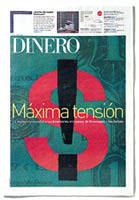La Vanguardia
Pablo Martin, who founded the Barcelona-based Grafica design studio with Fernando Gutiérrez in 1993, admits that he more or less fell into editorial design.

Pablo Martin, who founded the Barcelona-based Grafica design studio with Fernando Gutiérrez in 1993, admits that he more or less fell into editorial design. ‘We do a certain amount of packaging and corporate identity as well, and enjoy that mix,’ he explains. ‘But [de Las Tentaciones], opened lots of doors for us and we became known for editorial. Type is very important to us and, obviously, that’s a major part of newspaper design, so it comes quite naturally to us.’
Most recently, Martin has been busying himself with a pair of contrasting supplements for La Vanguardia, Spain’s major Catalan daily, which design-wise at least, is best known for ground-breaking treatment it received at the hands of Milton Glaser and Walter Bernard.
‘It was a schizophrenic couple of months, because they were such different solutions,’ recalls Martin. Dinero (meaning money) was a new financial magazine that Grafica had to design from scratch, while Revista (meaning magazine) was an existing news and lifestyle title that was given an overhaul. Published on a Sunday, Dinero comes inside Revista, which in turn sits inside the main paper.
Naturally enough, Martin set out to create a dramatic differentiation between the two titles – but with a twist. Dinero, with its serious financial thrust, was given a surprisingly contemporary treatment, with illustrations by Barcelona-based Brit Patrick Thomas and using different weights of DIN Mittelschrift as the major typeface. ‘[DIN is] used for the road sign system in Germany,’ he explains. ‘I wanted a strong and cold approach to information. It has that German precision, it’s well finished and works well at very small sizes.’
For Revista, which required a ‘more playful interplay of type and image’, Martin chose Modern, a classical 19th century typeface with slightly exaggerated straight serifs, for headlines, while retaining Times Roman with a five-column grid system for body copy. ‘The idea was to use Modern big, so you could really see the shape of the letters and use them to decorate the page,’ he explains.
Meanwhile, the no-nonsense Akzidenz Grotesk was used sporadically as a visual counterpoint, as well as for the masthead and section titles, with its ascenders carefully pruned. ‘At first I made the masthead small, as I knew it wouldn’t have to make a splash on the news-stands,’ says Martin. ‘Then I changed it around altogether and used a very big masthead – that way the cover works even if the image isn’t particularly good.’
At La Vanguardia, Martin is doing battle with the dreaded Hermes layout system. ‘It’s good for strong, classical newspapers, but it’s technically difficult. You have to know what you want. I’ve tried to leave an “album” of possible solutions, but it’s tricky educating people to apply the design after you’ve gone.’
-
Post a comment



